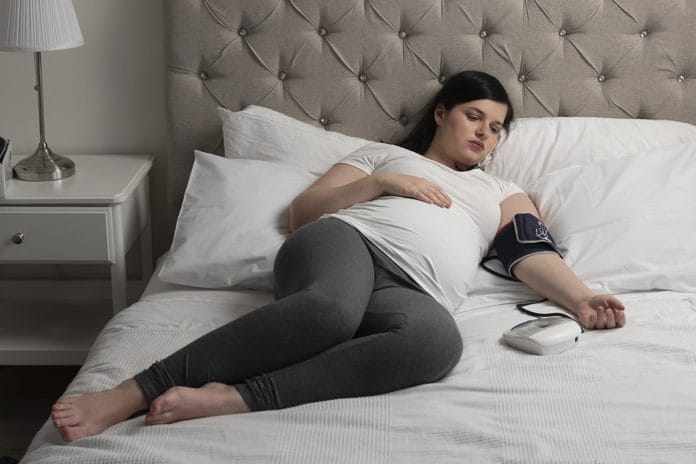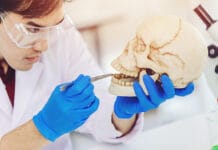“Preeclampsia is a disorder that occurs only during pregnancy and the postpartum period and affects both the mother and the unborn baby,” the Preeclampsia Foundation states, “Preeclampsia affects at least 5-8% of all pregnancies and is a rapidly progressive condition characterized by high blood pressure and usually the presence of protein in the urine.”
The condition usually occurs after 20 weeks of gestation. If left untreated, it can lead to serious illness that can include preterm delivery, low birth weight, organ damage, seizures, future cardiovascular disease, and, in severe cases, death to both the mother and fetus.1
The most common symptoms moms-to-be may notice are a sudden swelling of the face, hands, or feet, rapid weight gain, headaches, and visual changes. If left untreated, there is research that indicates women who suffer from preeclampsia are more likely to have more severe periodontal disease and are “four times more prone to losing their periodontal attachments.”2 This means that our periodontal examinations on our pregnant patients should be extremely detailed and thorough.
Since my office specializes in periodontics, it is our protocol to chart probe depths, recession, mobility, and CAL at every hygiene and periodontal maintenance visit. Some offices may routinely do this once a year. I would encourage hygienists to consider doing this at each visit with their pregnant patients so that any problems can be treated early in hopes of avoiding any potential danger to their unborn baby. As hygienists, we know how quick the destruction periodontal disease can cause, sometimes despite both ours and our patients’ best efforts.
The Bacterial Role
Hygienists are familiar with the role the bacteria P. gingivalis plays in periodontal disease; it is one of the most destructive oral pathogens. One study that took samples of cord blood from expectant mothers who suffered from preeclampsia found the oral pathogen within the samples. We know that oral bacteria can be found in other parts of the body like the brain and arteries around the heart, but this finding means that microorganisms can get into the systemic circulation of the mother and potentially travel to the unborn fetus, leading to potentially life-threatening dangers.3
What Hygienists Can Do
Because of the evidence mentioned above, stressing the importance of good oral hygiene and routine dental care with our expectant mothers is critical. Many moms will be more motivated to practice good home care when they understand that not doing so may pose a risk to their unborn baby.
We can educate our moms-to-be that women who currently have periodontal disease are more likely to develop preeclampsia than their pregnant counterparts who don’t.3 It is important to note that a past history of periodontal disease has also been associated with severe preeclampsia.4
Routinely taking blood pressure is a good practice for all of our patients, but taking it on our pregnant patients can be extremely important. Even though blood pressure is typically taken at each prenatal visit, preeclampsia can have a sudden onset, so it is vital we check our patients even if they have recently been evaluated by their obstetrician.1
A detailed health history is crucial, as well. For example, ask the patient if she has developed any sudden symptoms. Hygienists are a part of the patient’s health-care team and are treating more than just their oral health. We routinely educate our patients on the link between periodontal disease and other systemic links such as diabetes and heart disease, and so we should take this same approach with our moms-to-be. Recommending oral hygiene routines, products, and adjunct tools are all things we are also familiar with as hygienists-these recommendations should be specific to the patient. If the patient is currently on a six-month recall, we should consider shortening their recall to three or fourth-month intervals throughout the pregnancy and potentially into the postpartum period.
A good extraoral examination can help, as well. If the patient appears to have extreme swelling anywhere on the body, especially in the face, hands, or feet, it is important to discuss it with the patient and recommend they contact their obstetrician as soon as possible.
If a patient winds up in our chair and has already been diagnosed with preeclampsia, we can educate her on the things that are within her control to prevent periodontal disease. It is important to impress upon the patient that even despite her best efforts at good home care and regular dental follow-ups, her preeclampsia predisposes her to periodontal disease, and that is something that is out of her control. Patients may find this very frustrating and discouraging, so it is our job to encourage and support them.
Final Caution
It is important to note that some mothers will develop postpartum preeclampsia, which can occur up to 12 weeks after delivery.4 If the patient has periodontal disease, it may not be well controlled until the preeclampsia has disappeared. This is why it may be important to see these patients more frequently for hygiene recalls during their postpartum period.
If you happen to find a new mom in your chair, check her blood pressure.
Now Listen to the Today’s RDH Dental Hygiene Podcast Below:
References
- Preeclampsia. Mayo Clinic. Retrieved from https://www.mayoclinic.org/diseases-conditions/preeclampsia/symptoms-causes/syc-20355745
- Varshney, S., Gautam, A. Poor Periodontal Health as a Risk Factor for Development of Pre-eclampsia in Pregnant Women. J Indian Soc Periodontol.2014 May; 18(3): 321-5. DOI: 10.4103/0972-124X.134569. Retrieved from https://www.ncbi.nlm.nih.gov/pubmed/25024545
- How, K.Y., Song, K.P., Chang, K.G. Porphyromonas gingivalis: An Overview of Periodontopathic Pathogen below the Gum Line. Front Microbiol.2016 Feb 9; 7: 53. DOI: 10.3389/fmicb.2016.00053. eCollection 2016. Retrieved from https://www.ncbi.nlm.nih.gov/pubmed/26903954
- Boggess, K.A., Berggren, E.K., Koskenoja, V., Urlaub, D., Lorenz, C. Severe Preeclampsia and Maternal Self-Report of Oral Health, Hygiene, and Dental Care. J Periodontol. 2013 Feb; 84(2): 143-51. DOI: 10.1902/jop.2012.120079. Epub 2012 Apr 17. Retrieved from https://www.ncbi.nlm.nih.gov/pubmed/22509752












